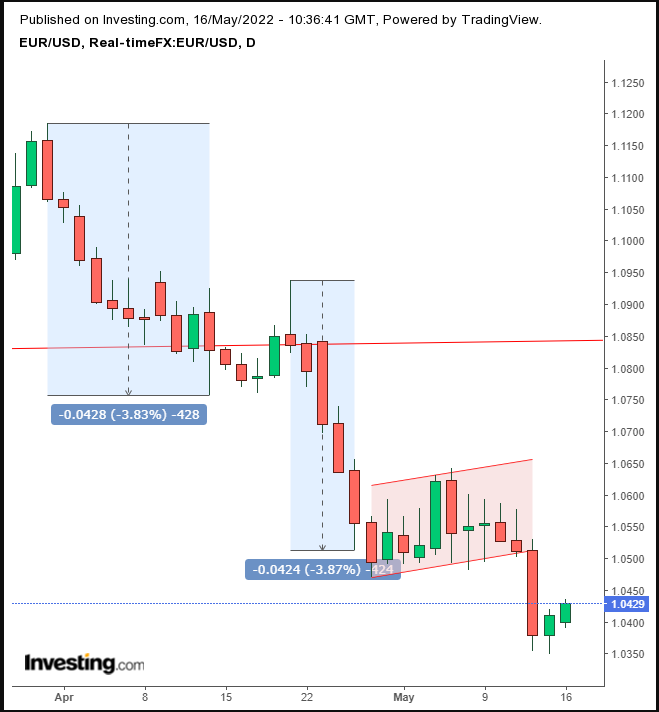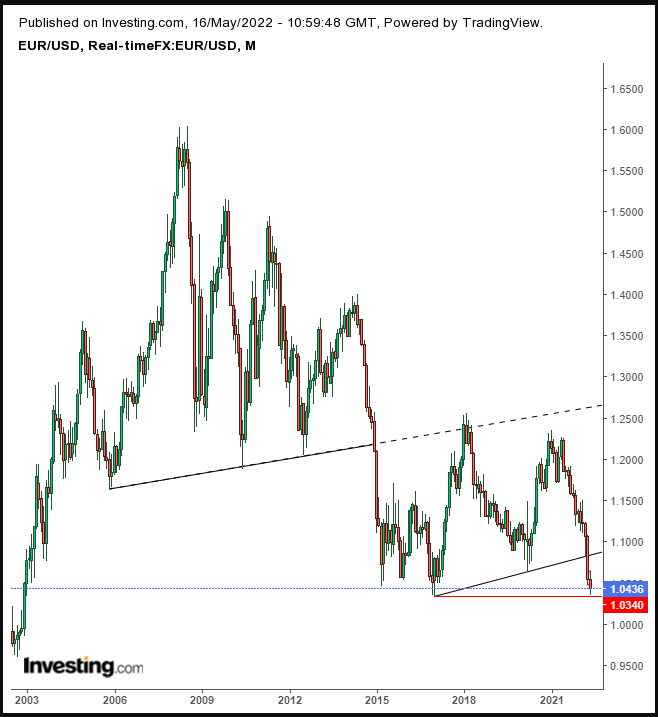After a three-day selloff, the euro is extending its rebound to a second day. However, before traders conclude the single currency is bottoming, they should look at the following chart.
The current climb follows a Rising Flag, a 3.87% move within six sessions which provided a period of rest for bears. To appreciate the magnitude of the movement, the EUR/USD pair fell 3.83% between the Mar. 31 peak and the Apr. 15 low, which was 11 sessions and twice as long as the last move.
So, bears locked in profits. However, the tide hasn't changed as the pair then broke to the downside, demonstrating that supply was still overrunning demand.
Therefore, any bounce after a bearish flag is suspected to be nothing more than a 'return move to retest the pattern' in technical jargon. The mechanics include a short squeeze and dip-buying, which, when proven wrong, only intensifies the next leg lower.
The euro is near a twenty-year low versus the dollar, and smart money is betting on parity, in as little as six months, due to slower growth or even a recession.
The primary culprit is surging energy costs as the EU is considering boycotting Russian energy exports. Soaring energy prices are also the core driver of rising inflation and reduced economic growth forecasts for Europe.
Traders are putting their money where their mouths are. There has been a significant increase in betting that the pair will achieve parity and a majority of FX traders responded to a recent survey that the euro will decline to $1. Analysts are waiting to see if the currency will fall below the 2017 low as it is close to breaking the last support above parity. It has, however, already broken a significant, less obvious support.
In April, the pair completed an oversized Upward Sloping H&S Continuation pattern when crossing below the rising trendline since the 2016 low. That pattern's implied target from the height of roughly 1.0800 to the breaking point 1,700 pips lower is 0.91, which is well below parity.
However, the H&S top that preceded that move—whose neckline maintained its resistance above the H&S Continuation Pattern—was even more significant from 2014 through 2015. The measuring implications of that H&S, from the top of 1.22 to the breaking point of 3,800 pips lower, implies a target of 0.84, testing the 2001 lows, the lowest since the euro was launched.
Trading Strategies
Conservative traders should wait for the price to complete the full Return Move potential to 1.0500, demonstrating resistance, before risking a short position.
Moderate traders could short as the price nears the flag for a better entry.
Aggressive traders may enter a long contrarian position, counting on the bounce, before joining the rest of the market in a short. Money management is essential. Here is an example:
Trade Sample - Aggressive Long Position
- Entry: 1.0375
- Stop-Loss 1.0350
- Risk: 25 pips
- Target: 1.0475
- Reward: 100 pips
- Risk-Reward Ratio: 1:4
Trade Sample - Follow Up - Short Position
- Entry: 1.0500
- Stop-Loss: 1.0525
- Risk: 25 pips
- Target: 1.0400
- Reward: 100 pips
- Risk-Reward Ratio: 1:4



